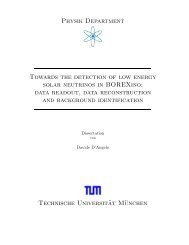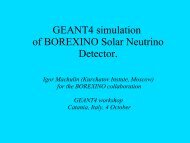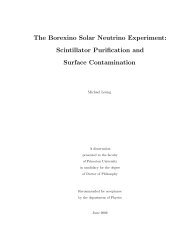Development of a Liquid Scintillator and of Data ... - Borexino - Infn
Development of a Liquid Scintillator and of Data ... - Borexino - Infn
Development of a Liquid Scintillator and of Data ... - Borexino - Infn
You also want an ePaper? Increase the reach of your titles
YUMPU automatically turns print PDFs into web optimized ePapers that Google loves.
4.2 The Tracking <strong>of</strong> the Scintillation Photons<br />
4.2 The Tracking <strong>of</strong> the Scintillation Photons<br />
In the Monte Carlo simulation each photon is tracked from the place where it was produced<br />
to the place where it is absorbed or detected. The propagation <strong>of</strong> the photon in the transparent<br />
media <strong>of</strong> the detector (scintillator, water) is described by optical laws. In the tracking procedure<br />
the scintillation decay, the absorption <strong>and</strong> reemission <strong>of</strong> photons, the light scattering,<br />
the reflection or refraction on the border <strong>of</strong> different media, the reflection on the light guide<br />
surface <strong>and</strong> the photo multiplier time jitter are taken into account.<br />
The Scintillation Process<br />
Ionizing radiation passing through the organic scintillator transfers energy to the scintillator<br />
molecules. A fraction <strong>of</strong> this energy goes into the excitation <strong>of</strong> scintillator molecules which<br />
relax back to their ground state <strong>and</strong> sometimes emit light in this process, the remainder is<br />
dissipated nonradiatively. Due to the decay into lower energy states <strong>of</strong> the excited scintillator<br />
molecules the generation <strong>of</strong> scintillation photons is delayed a time Ø. The distribution <strong>of</strong> this<br />
delay is described by an exponential probability density function Ø where the parameter<br />
is the scintillation decay time. Generally the scintillator has more than one component,<br />
where each component is characterized by its decay time <strong>and</strong> its intensity Õ. The different<br />
components are due to different excited states <strong>of</strong> the molecules, which will be explained in<br />
more detail in chapter 5. The probability density function is<br />
Ø Õ Õ<br />
Ø <br />
Õ <br />
<br />
<br />
Figure 4.1: Normalized emission spectra <strong>of</strong> PC <strong>and</strong> È ÈÈÇ Ð .<br />
<br />
47








